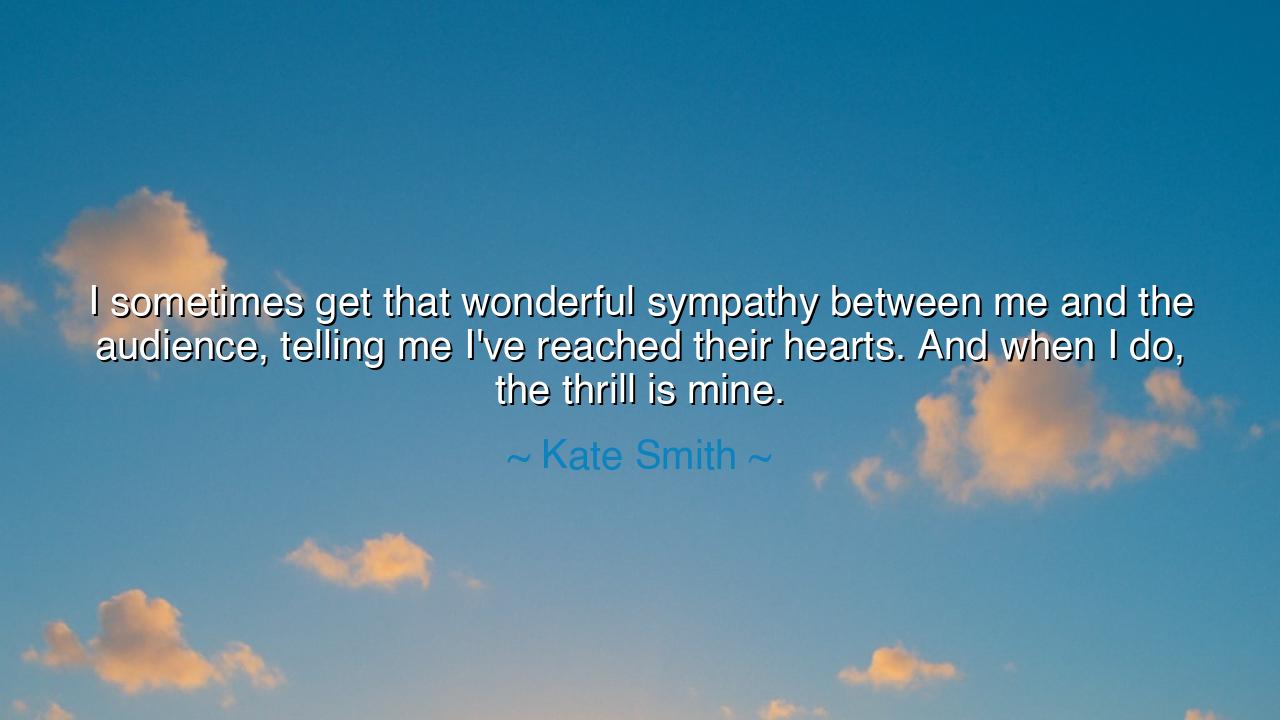
I sometimes get that wonderful sympathy between me and the
I sometimes get that wonderful sympathy between me and the audience, telling me I've reached their hearts. And when I do, the thrill is mine.






Hear now the words of Kate Smith, a voice once hailed as the Songbird of America, who gave her life to the art of stirring hearts through song. She declared, “I sometimes get that wonderful sympathy between me and the audience, telling me I’ve reached their hearts. And when I do, the thrill is mine.” These words are not idle musings, but a testament of a life devoted to communion through art. They speak of the mysterious bond that unites speaker and listener, singer and hearer, soul and soul, when sound becomes more than sound—it becomes spirit.
Smith, who rose during the dark years of the Great Depression, understood that music was more than melody; it was balm to the wounded. She lent her voice to "God Bless America," a hymn of hope sung in days of war and uncertainty. Crowds gathered not merely to hear a performance, but to feel the resonance of their own longing for strength, peace, and unity. And in that moment of shared sympathy, when their burdens echoed in her song, she knew she had reached their hearts. This is the thrill she spoke of: the exaltation not of applause, but of connection.
There is an ancient parallel in the story of Demosthenes, the great orator of Athens. He was not born eloquent—he stuttered, he faltered, he was mocked. Yet through discipline and burning desire, he taught his voice to rise like thunder and fall like gentle rain. One day, addressing the people, he felt their silence deepen, their breath match his cadence, their hearts rise with his words. That was his triumph—not in conquest or wealth, but in that unspoken union between speaker and people. So too with Smith: the victory is not in the note itself, but in the souls that tremble at its sound.
What lesson lies here for the seekers of truth and art? It is this: the greatest gift of expression is not the praise one receives, but the bridge it builds. To write, to sing, to speak, to act—these are not ends in themselves. They are vessels that carry the fire of one heart into another. The thrill is not the coin of fame, but the knowledge that one’s truth has lit another’s candle, that the darkness in another soul has been lessened by a spark.
Yet this communion is not gained through trickery or shallow craft. One must give of themselves wholly, without mask, without pretense. When Kate Smith sang, she poured her sincerity, her love of country, her compassion for the weary into every note. It is this honesty that stirred hearts, for people know when they are being moved by truth and when they are merely being entertained. True art does not aim at admiration; it aims at recognition—the recognition of the self within another.
Therefore, beloved reader, if you seek to create, to inspire, to speak—do not chase the shadow of applause. Instead, pour yourself fully into the work, into the offering. Let your aim be not to impress but to connect. Seek that sympathy which binds souls together. It will not come every time, but when it does, you will feel that holy thrill that Smith described—the confirmation that your work has transcended self and become shared life.
In your daily practice, strive for this: when you speak with a friend, listen with your heart, not just your ears. When you labor in your craft, ask not “Will this be praised?” but “Will this touch another’s soul?” When you walk among strangers, seek to leave warmth rather than indifference. For in these small acts of reaching, you will learn the art of sympathy—the sacred exchange that makes life worth living.
And remember, as Kate Smith taught us: the thrill belongs not to the one who receives the applause, but to the one who dares to touch another’s heart with truth. That is the highest joy, the greatest victory, and the eternal reward of those who give of themselves fully.






AAdministratorAdministrator
Welcome, honored guests. Please leave a comment, we will respond soon